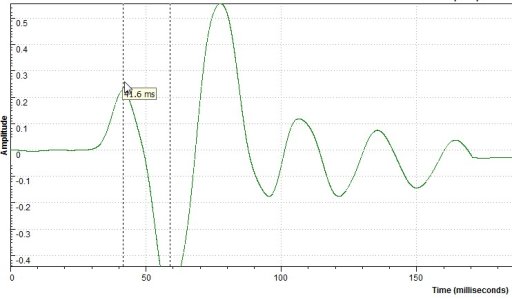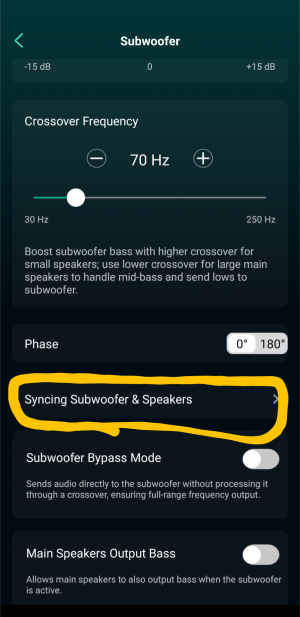You are using an out of date browser. It may not display this or other websites correctly.
You should upgrade or use an alternative browser.
You should upgrade or use an alternative browser.
Completed Automatic timing alignment for Main Speakers and Subwoofer
- Thread starter WiiM Team
- Start date
Beta testing concluded and stable version released to the public builds.
Manual adjustments are already in place.There is no manual adjustment? I hope it!
Oh is there a manual delay adjustment tab? I'm looking for wiim, and I used it few months ago, so I didn't know about it!Manual adjustments are already in place.
MrA
Senior Member
- Joined
- Sep 16, 2024
- Messages
- 378
Unless the sub is right next to the music listening (& mic) position and the speakers are far away it would not be normal for any adjustment to be made to the sub therefore the WiiM calculation is within a range that would be expected.Just tried it. It doesn't tell you which microphone it is using which I thought was strange. I used the iMM6. It plays a high tone followed by a gap then a mixture of tones another gap and finally a low tone. The automatic result was 8ms latency adjustment of the main speakers. My previous manual adjustment was 6ms latency adjustment of the subwoofer. I have no idea about the methodology behind the automatic setting or if the setting is correct or not. It sounds fine to me with both settings.
slartibartfast
Major Contributor
- Joined
- Apr 18, 2024
- Messages
- 5,161
The sub is sitting between the main speakers next to the right speaker. I don't have any reason to doubt the result but it would be nice to know how it was arrived at.Unless the sub is right next to the music listening (& mic) position and the speakers are far away it would not be normal for any adjustment to be made to the sub therefore the WiiM calculation is within a range that would be expected.
On AVR when doing room correction they go by feet. I’m not sure how many ms per foot.The sub is sitting between the main speakers next to the right speaker. I don't have any reason to doubt the result but it would be nice to know how it was arrived at.
slartibartfast
Major Contributor
- Joined
- Apr 18, 2024
- Messages
- 5,161
Yes I have heard that before but these are right next to each other.On AVR when doing room correction they go by feet. I’m not sure how many ms per foot.
MrA
Senior Member
- Joined
- Sep 16, 2024
- Messages
- 378
It's possible that there is a phase anomaly between sub and speakers so the WiiM algorithm is delaying the speakers more because of this. An 8ms delay is 'virtually' placing your main speakers 2.7m* behind the sub so that the sound peaks hit the microphone concurrently. It might be worth reversing phase on the sub and repeating the measurement.The sub is sitting between the main speakers next to the right speaker. I don't have any reason to doubt the result but it would be nice to know how it was arrived at.
I will try to explain using these examples from old measurements taken from my system using an Earthworks M23 Mic
The top image is the initial impulse peak of the main speakers (37ms)
The Lower image uses the initial impulse peak of the sub (41.6ms) as shown by the first dotted vertical line.
So the delay to the main speakers needs to be 41.6 - 37 = 4.6ms
However if the phase on the sub was reversed 180deg then that image would be upside down & the large dip would then be the initial peak at 59ms (second dotted line) so the delay required for the main speakers would now be 59 - 37 = 22ms.
Neither speakers nor sub have changed position in the room but a change in phase changes the point in time that the signal arrives.
In your case I suspect that the WiiM algorithm has made the 'correct' adjustment so you do not need to worry!


(*sound travels at 0.343 meters per millisecond so 8ms = 2.744m)
Last edited:
With measured timing did the sub and speakers sync seamlessly and made the sound cohesive and engaging?Yes I have heard that before but these are right next to each other.
slartibartfast
Major Contributor
- Joined
- Apr 18, 2024
- Messages
- 5,161
That could well be the reason. Before I started using the delay I did have the phase set to 180 degrees. I will try repeating the measurement with the phase reversed if only to see if the delay changes.It's possible that there is a phase anomaly between sub and speakers so the WiiM algorithm is delaying the speakers more because of this. An 8ms delay is 'virtually' placing your main speakers 2.7m* behind the sub so that the sound peaks hit the microphone concurrently. It might be worth reversing phase on the sub and repeating the measurement.
I will try to explain using these examples from old measurements taken from my system using an Earthworks M23 Mic
The top image is the initial impulse peak of the main speakers (37ms)
The Lower image uses the initial impulse peak of the sub (41.6ms) as shown by the first dotted vertical line.
So the delay to the main speakers needs to be 41.6 - 37 = 4.6ms
However if the phase on the sub was reversed 180deg then that image would be upside down & the large dip would then be the initial peak at 59ms (second dotted line) so the delay required for the main speakers would now be 59 - 37 = 22ms.
Neither speakers nor sub have changed position in the room but a change in phase changes the point in time that the signal arrives.
In your case I suspect that the WiiM algorithm has made the 'correct' adjustment so you do not need to worry!
View attachment 13301
View attachment 13302
(*sound travels at 0.343 meters per millisecond so 8ms = 2.744)
slartibartfast
Major Contributor
- Joined
- Apr 18, 2024
- Messages
- 5,161
As far as I can tell yes.With measured timing did the sub and speakers sync seamlessly and made the sound cohesive and engaging?
Good, thanks!As far as I can tell yes.
Tiny addition: Generally speaking, a latency of 8 ms is virtually placing the mains ~2.7 m behind their own physical position, regardless of where the sub is. In this case the distance to the sub is assumed to be identical to the distance to the mains, so the above statement is still true, of course.An 8ms delay is 'virtually' placing your main speakers 2.7m* behind the sub so that the sound peaks hit the microphone concurrently.
As can be seen in those screenshots, it's quite a bit harder to exactly determine the location of the initial impulse peak of the sub automatically (irrespective of the polarity setting, colloquially referred to as phase). The high frequency components required for a sharp peak are missing due to the limited bandwidth. The fact that WiiM have created a new measurement signal tells me they've been actively working on this and the results appear to be very promising.In your case I suspect that the WiiM algorithm has made the 'correct' adjustment so you do not need to worry!


2.7 m may sound like a lot of delay at first, but there are more reasons why it's usually the mains that need to be delayed. One is purely acoustical. For a mid and high frequency signal the source of the sound is pretty much identical to the position of the tweeter in 3D space. This is not true for the long wavelength low frequency signal emitted by the subwoofer (which is usually located closer to the front wall). Those low frequencies are bend around the sub's cabinet and reflected by the front wall, which acts very much like a mirror. As a result, the effective position of the sound source in 3D space is usually close to the front wall.
Also, many - but not all - subwoofer plate amps do introduce a certain latency. Class D amps have a delay, but this is in the order of microseconds, not milliseconds, and can be safely ignored. Delay caused by the DSP found in many subs however is in the order of milliseconds and will need additional latency for the mains for best results.
Do you know more than the rest of us does?I think wiim will stop refining their rc once the timing, independent peq rc, auto level and multiple sweep are out in public.
D
Deleted member 10021
Guest
I’m currently on the beta for my WiiM amp. Is the subwoofer sync built into the room correction? Because I can’t seem to find it in the subwoofer settings. Thanks!
slartibartfast
Major Contributor
- Joined
- Apr 18, 2024
- Messages
- 5,161
When you run rc does it include the timing in all the process?It's in the subwoofer settings
View attachment 13318
D
Deleted member 10021
Guest
I see that menu in my settings. The thing is nothing has changed. It’s still the manual settings.It's in the subwoofer settings
View attachment 13318

Did you have the latest app?I see that menu in my settings. The thing is nothing has changed. It’s still the manual settings.
View attachment 13319
D
Deleted member 10021
Guest
That’s what I was wondering.When you run rc does it include the timing in all the process?
Similar threads
- Replies
- 105
- Views
- 7K
- Replies
- 3
- Views
- 521
- Replies
- 0
- Views
- 1K
- Question
- Replies
- 17
- Views
- 2K
- Replies
- 175
- Views
- 12K

